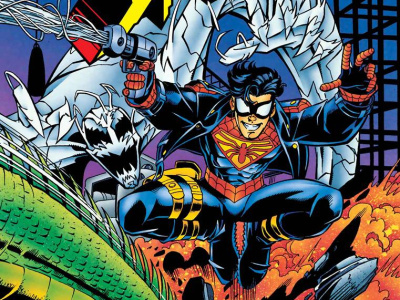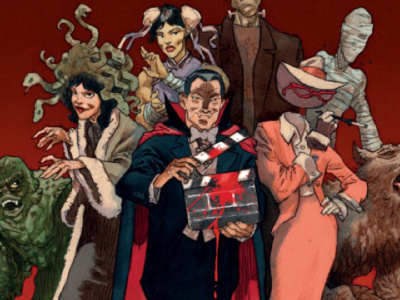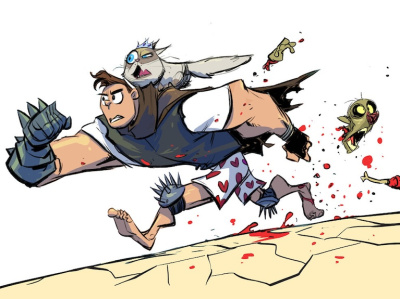As we predicted last month (see 'Comic Dollars Down Again in November'), the fourth quarter over-all was down (8%) vs. 2001, with a stronger graphic novel showing (up 3%) unable to outweigh an 8% drop in periodical comic orders. It's worth noting that despite the decline in Q4 of 2002, Q4 2002 orders remained about 1% above Q4 2000.
But a weak fourth quarter was unable to drag the total numbers for the year negative. For the first time in nearly a decade, the full year was up a robust 8% over 2001, with a 7% increase in comic orders and a 20% increase in graphic novel orders. That compares to a 3% drop in 2001 vs. 2000, with other drops in market size probably stretching back to 1994 or 1995.
Annual Year over Year Comparisons
| Comics | Graphic Novels | Total |
2002 vs. 2001 | +7% | +20% | +8% |
2001 vs. 2000 | - 3% | + 6% | - 3% |
The quarterly trends give a better picture of what's been happening over the last couple of years, with the numbers turning positive for the first time in Q4 of 2001 and extending for a total of four consecutive quarters.
Quarterly Year over Year Comparisons
| Comics | Graphic Novels | Total |
Q1 2001 vs. 2000 | - 6% | +19% | - 4% |
Q2 2001 vs. 2000 | -17% | +26% | -14% |
Q3 2001 vs. 2000 | - 3% | +15% | - 1% |
Q4 2001 vs. 2000 | +12% | -17% | + 9% |
Q1 2002 vs. 2001 | +11% | +54% | +15% |
Q2 2002 vs. 2001 | +19% | +22% | +19% |
Q2 2002 vs. 2001 | + 8% | +12% | + 8% |
Q4 2002 vs. 2001 | - 8% | + 3% | - 7% |
Marvel was the big winner for the year as a whole, with a 14% increase in its comic and graphic novel orders vs. 2001. The rest of the Big Four were all down, with DC, Image, and Dark Horse dropping 2%, 7%, and 6%, respectively vs. 2001. Those trends changed dramatically in Q4, with Marvel, DC, and Dark Horse down 20%, 11%, and 14% in Q4 2002 vs. 2001, and Image up 8%.
We have a couple of reflections on the numbers reported above, which actually lead toward predictions in opposite directions. First, comics, like all entertainment businesses, are hit-driven, and it may simply be that the fourth quarter of 2002 was short on hits vs. other recent quarters, and that we'll see a return to growth in periodical comic sales if there's more creative strength in 2003. Second, looked at in a longer term context, it's possible that the four quarters of growth in periodical comics were an aberration, and that the over-all trend of strength in book formats and weakness in periodical formats is re-asserting itself.
Another major trend from 2002 that is not apparent from the numbers above (which reflect only advance orders from comic stores) is that for the first time since the magazine distribution system began going through its paroxysms in the early 90s, non-comic store distribution channels for comic material (bookstores and other specialty retail chains, and to a lesser extent mass merchants) are becoming important for a larger number of publishers. This is significant for several reasons. First, publishers are now planning for book distribution to a much greater degree than they were in the past. For example, Marvel has finally awakened to the opportunity presented by publishing periodical comics in story arcs that can be conveniently repackaged. And more publishers are now releasing new comic material directly to book format rather than publishing first in periodicals, then collecting the material into books (e.g., Tokyopop), or as in the case of CrossGen, are repackaging older material into special packages primarily for book channels. Second, the expansion of distribution into more pockets in more stores represents a tremendous opportunity for the growth of the comic industry as a whole. And third, to the extent that other channels become more important, comic publishers are going to view the full range of distribution options when choosing what material to publish, which will cause creative material to trend away from superheroes and toward other genres. This can feed more growth in the industry as a wider range of consumers become aware of and begin enjoying comic material
All things considered, 2002 has been a very good year for comics, the best in many years. The retailers and publishers that take best advantage of the trends and their underlying causes have a great opportunity to make 2003 even better.
These estimates are based on ICv2 estimates of initial raw orders to Diamond North America on titles scheduled for shipment in December 2002. They do not include orders placed with Diamond UK, late orders, advance reorders, distributor over-orders, or reorders.
Marvel, DC, Dark Horse and Image distribute 100% of their comic store orders through Diamond. Some other publishers distribute directly to stores or through other distributors and as a result this analysis may underestimate their sales.
Marvel, DC, Dark Horse, and Image distribute some of their titles through channels other than comic specialty stores, e.g., newsstands and bookstores. These quantity estimates do not reflect distribution through those channels.
The quantities above do not include advance reorders, late orders, or reorders.
Most of the titles on this chart are also distributed to Europe by Diamond UK, which can account for significant sales for the publisher, ranging from 3-20% of the US numbers. Sales by Diamond UK are not included in the numbers above.
Even given the above, however, it is probably safe to say that these quantities reflect 80% or more of the total North American sales by the publisher on most periodical comics.
One other factor to consider is that sales through Diamond and other comic distributors are non-returnable to retailers. That means that there is a considerable unknown percentage of books unsold at the retailer level. If that percentage is 10-20% of sales (a reasonable assumption), the estimates above may be quite close to actual sales to consumers.
For an over-view and analysis of the best-selling comics and graphic novels in December, see 'Top Comics Still Soft in December.'
For the top 300 comics in December, see 'Top 300 Comics--December 2002.'
For the top 50 graphics novels in December, see 'Top 50 Graphic Novels--December 2002.'
For an overview and analysis of the dollar orders for November,
For the top 300 comics in November, see 'Top 300 Comics--November 2002.'
For the top 50 graphic novels in November see 'Top 50 Graphic Novels--November 2002.'
For links to all of the Top 300 Comic and Top 300 Graphic Novel orders, see our 'ICv2's Top 300 Comics & Top 50 GN's Index.'







